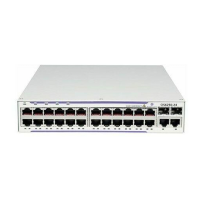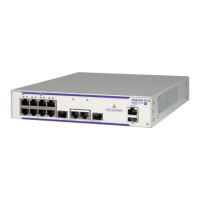Boot Option Files
7210 SAS D, E, K OS Basic System Configuration Guide Page 117
Auto Init
During the first boot or a reboot after the execution of CLI command admin reboot auto-init, if
the user does not intervene to create the BOF file in the manual mode, the system, by default, goes
to auto-init procedure after a “wait” time. The default wait time is 3 seconds. There are two
designated ports used for auto init. These are the front panel ports, port 1 and port 2. Auto init
requires a DHCP server to be configured in the network which should be reachable by the system.
DHCP requests are directed out of one uplink port at a time. All other ports of the system would be
down.
If a DHCP server is present in the network, the system expects to receive an IP address, the default
gateway information, and BOF file path in the response returned by the DHCP server. Upon
receiving these parameters from DHCP server, the system will apply the IP configuration and then
download the BOF file from the path given by the DHCP server. The BOF file is then saved into
the flash and is used for subsequent reboots. The bootstrap image then processes the BOF
parameters in order to boot the system. BOF processing is explained in Configuration and Image
Loading on page 118
The user is provided with an option to provide some of the BOF parameters before the box
attempts to use DHCP for obtaining the BOF file and the image files. It gives an opportunity to the
user to modify some of the link parameters (for example: speed) and the DHCP request (for
example: VLAN ID) to suit the deployment needs. The parameters that can be configured are the
uplink ports to use, VLAN ID used, speed of the link, the duplex setting for the link, and the auto-
negotiation capability for the link. To change this value, the user needs to have console access and
break the boot sequence and type in the keyword 'auto' to provide some of the BOF parameters
(follow the prompts to provide these parameters). After this is done, and ‘exit’ is typed, the
bootloader software uses these parameters to configure the link appropriately and then sends out
the DHCP requests to obtain the BOF file. The BOF file which obtained through DHCP must
contain the location of image file and config file (and values for other BOF parameters). If the
DHCP process is successful, the BOF file that is obtained from the network is copied to the local
flash. It is recommended that the user configure similar values for the BOF parameters that was
modified locally. In other words, if the user specified new values for the BOF parameters such as
speed, VLAN ID, auto-negotiate, and others. Before the start of DHCP requests, then the BOF
downloaded from the network should contain the same values for those BOF parameters. Please
see the flow chart below for more information.
The system first attempts to use uplinkA and then uplinkB parameters to receive a successful
response from the DHCP server. If there is no response from the DHCP server on both the uplink
ports, the boot procedure is restarted, during which the user can opt to enter the manual mode or
allow the system to default to auto-init again.
When the system fails to download image through auto-init. The system looks for the loads the
Timos image using the 'both.tim' file located on the local flash (that is, cf1:\both.tim on 7210 SAS-
D,E and the following location on 7210 SAS-K - cf1:\both.tim, uf1:\both.tim,
cf1:\*TIMOS*\both.tim and uf1:\*TIMOS*\both.tim). After successful bootup using the Timos

